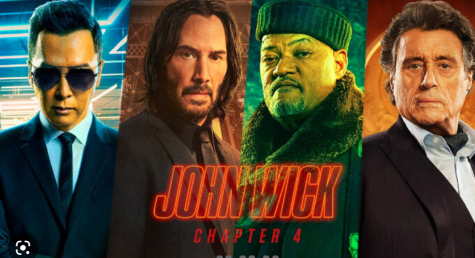John Wick Chapter 4 Review
April 12, 2023
Over the past decade, many action and thriller franchises have exhausted the classic theatrical tropes: high-speed car chases, advanced hand-to-hand combat, and even massive battle scenes chock-full of CGI. John Wick: Chapter 4, however, shows the audience why we love action and thrills in the first place through high-caliber execution of old classics.
The events of John Wick: Chapter 3 – Parabellum showed us the multitude of creative ways in which highly-skilled hit man John Wick dealt with the aftermath of being declared excommunicado from The Continental, the High Table, and the criminal underground. As a result, John lost all of his contacts, access to weaponry, and allies as the price on his head continued to grow. With this bounty growing ever-higher, Chapter 4 follows John Wick as he seeks revenge on the High Table through an incredibly captivating – and, of course, brutally violent – international journey.

Most action/thriller franchises have shown that even murder – especially with a record-breaking 140 kills in one film – can get old. However, Chapter 4 builds on the slight theme of comedy that was introduced in Chapter 3 by emphasizing John’s comically near-absence of dialogue, the blunt, rugged delivery of his signature catchphrase (“Yeah”, in case you missed it), and a particularly tricky case of getting up a set of stairs. Between that and a few dramatic villains, who knew that mass murder could be so theatrical?
We’re all familiar with the concept that anyone can be anything they want if they set their minds to it. The John Wick saga, however, takes this concept a step further by implying that anyone can be a highly-trained assassin – regardless of age, ethnicity, gender, ability, and… species? That’s right – Chapter 4 keeps with the trend by introducing both the most violent service dog known to man and a blind assassin named Caine who serves as John Wick’s reluctant friend and equally reluctant foe. Paired with the intense fight sequences, the introduction of a whole new cast of eccentric characters keeps the viewer engaged from beginning to end despite the movie’s nearly 3-hour runtime.

Chapter 3 certainly set the bar high in terms of lighting and sound, but Chapter 4 manages to exceed even those expectations by taking the cinematography to an entirely new level. The film features its staple car chase with breathtaking stunt work and heart-pounding theatrics, the token strobe-light club brawl, and even an entire scene shot aerially that highlights these films’ ever-impressive fighting choreography. In keeping with the standard of the previous films, Chapter 4’s fight scene choreography is as smooth, delicate, and refined as a trained dancer sweeping across the stage, just toeing the line between brutal and beautiful. And as if that wasn’t enough, the stunning lighting and intense soundtrack – with everything from electronic tracks with pounding bass to high-energy French covers of classic songs – will undoubtedly transport the viewer into the John Wick world of crime and chaos.
Unlike its predecessors, the main focus of Chapter 4 shifts from feeling like a mafia-style movie interspersed with increasingly creative ways of killing a person to more mature themes like grief, loss, and vengeance. After three movies, it’s easy to forget that John Wick only left retirement because of the death of his wife and a misstep on the part of the Russian mafia that led to one dead dog, one outraged grieving man, and a trail of bodies. In Chapter 4, however, we see John grapple with the realities of losing his wife and the potential of freedom from his life of violence and crime. Believe it or not: at its very core, John Wick is a movie about family – from the bonds of The Continental staff to John’s relationship with his wife to even the familial sacrifices made by the assassins chasing John.

While John Wick himself only has roughly 380 words of dialogue in the entire film, every word of Chapter 4 packs a punch when delivered in Keanu Reeves’ signature minimalist acting style that isn’t good, per se, but is certainly effective. In other words, the film embodies the proverb that actions certainly speak louder. However, silence and violence aren’t the only themes running rampant in the story: the film also incorporates a surprising number of biblical, religious, spiritual, and mythological overtones in everything from faith to devotion to hubris. On the surface, the viewer is watching John Wick waste dozens of people with a single handgun and seemingly endless ammunition, but beneath that Kevlar facade are essential questions: What is good and what is evil when both sides are lost to immorality? What is the difference between living for someone and dying for someone? How long can you run from the past, and at what point do you begin to embrace it?
Above all, everything comes down to actions and their consequences, and what one is willing to bear. But of all the questions to be asked, the most important remains: With an incredibly ambiguous ending, will there be a Chapter 5?
For now, the only question you should be considering is: Should I see John Wick: Chapter 4?
To quote John Wick, the simple answer? “Yeah.”



















